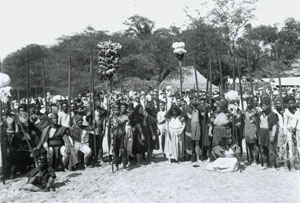Demonstration Papers: The People of Paradise

The representation of Hawaiian culture resides at the core of any understanding of local culture. What it means to be local is in many ways premised on specific understandings of Hawai'i and Hawaiians. In the years after the overthrow of the monarchy, Hawaiian culture was successfully divorced from the potentially dangerous political nationalism that emerged during the movements to resist annexation and Euroamerican domination.
In the early years of the Territorial period we begin to see the expression of nostalgia for the old days of the monarchy. In the late 1920s there was an initiative in the Territorial legislature to create a Hawaiian village which would help to preserve the dying culture. There was, of course, resistance on the part of Hawaiians to be exploited like side-show acts, but in 1932, the Mossman family opened Lalani Village in Waikiki. Billed as both a tourist attraction and an educational institution, Lalani Village became a respected museum/tourist destination. Like a later incarnation, the Polynesian Culture Center, sites like these are open to questioning not just about their authenticity, but about the ways in which cultures are appropriated and to what end cultural products are used.

Hawaiian culture had long been the object of a deeply patronizing romantic gaze by Others. The continuation of this tradition into the 20th century was especially debilitating in the context of tourism. Hawaiian culture was reduced to that which is saleable, pleasing, and conforming to the stereotyped image of Hawaiians as warm, open, and loving.

